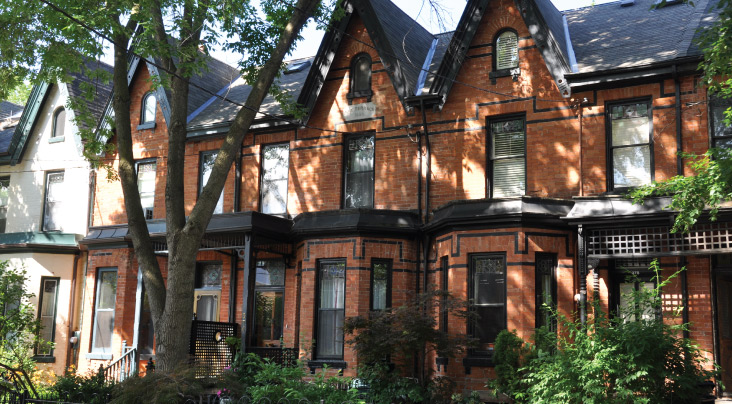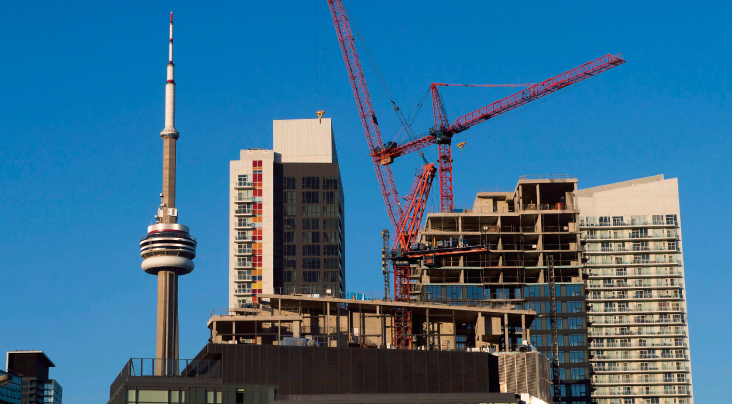June was an absolute slog. I’ll be the first to admit that.
And if you had asked me coming into today how I feel the GTA average home price for the month of June would fare, I would have suggested that it would decline significantly.
It’s amazing to witness how quickly the market can change, and after nearly four months of working in a seller’s market where “offer nights” and multiple offers were the norm, the picture really changed when we hit June 1st.
Now, whether or not this affected price remains to be seen, but the process of selling real estate became a whole lot different.
I had clients preparing to sell an east-side home, for whom I was preparing a realistic picture of what to expect.
I shared a Microsoft Excel worksheet through Google Drive and began to track every property listed on the east-side under $2,000,000. I wanted them to watch, in real time, how houses were selling out there, and the results were interesting.
One of the most important metrics we were tracking was the success or failure of “offer dates.” Price aside, knowing how properties were selling (or not) was going to be very, very important.
In the first week, I noted that only 30% of offer dates were working.
In the second week, that figure dropped to 24%.
And in the third week, only 18% of properties that were listed with offer dates ended up selling on their respective “offer nights.”
Of course, we still listed ours with an offer date, because it’s almost more awkward and confusing for the buyer pool to see a fresh, well-presented, new listing coming to market at a higher price – without an offer date.
We received two offers on our offer night but didn’t accept either, and instead sold the house several days later.
As for the price, I’m not going to lie and say, “We got more money than we would have in the spring!” The market has changed, there’s a ton of inventory, and prices are down.
I felt we came in about 2.5% lower than what I would have liked to see in March or April, and while that’s real money when it’s sitting in front of you on the dining room table, as far as the asset price goes, it’s only 2.5%.
It’s impossible to “time the market.” Imagine being a seller watching the market increase in February, then March, then April, then May…
…when do you want to sell your home? When do you pull the trigger?
Of course, not everybody has the option of waiting 4-6 months, as some people sell because they have bought, and others sell because they’re starting a new job in Boston in two weeks.
But if history is any indication, the average home price was going to drop from May to June, no matter what. I’ll show you why shortly.
June showed us that while the prices have been moderately impacted, the process of selling a property right now has changed significantly. Sales are down, listings are up, and agents can’t expect to stick a sign on the front lawn and sit back and wait.
June also showed us that those failed offer dates are rampant right now and the “new listings” statistic has been impacted significantly. Just consider how many more “new listings” there are when so many offer nights are failing and properties are being re-listed. Sure, that’s a “new” listing per TRREB stats, but it’s not.
Right?
We’ll come back to that at the end when I provide you with a fun statistic that TRREB just introduced two years ago.
But let’s start where we always do with the average sale price in the GTA:

As I said, I expected this decline to be more pronounced, but prices seem to be – to use an economic term – sticky.
According to Investopedia:
Price stickiness is the resistance of a market price to change quickly, despite shifts in the broad economy suggesting a different price is optimal.
“Sticky” is a general economics term that can apply to any financial variable that is resistant to change. When applied to prices, it means that the sellers or buyers of certain goods are reluctant to change the price, despite changes in input cost or demand patterns.
That rings true, doesn’t it?
Sales are down, inventory is up, and the average home price is only off by 0.3%.
In this space last month, I noted:
Sales are at all-time low levels. But prices aren’t just holding; they’re increasing.
That does not conform with the laws of supply and demand that we great up studying, and yet there’s no other conclusion to draw except this: the Toronto market is resilient.
Then I took some heat in the comments section from people who felt that I was cheerleading, but maybe if I provided the definition of “price stickiness” last month then more of the readers would have just nodded their heads?
Last week, I was carrying nine listings.
But only two of those clients “need” to sell.
That’s the difference in this market, where sellers aren’t forced to accept less than they want to and can terminate the listing and sell this fall or next year. I have to think this is impacting the price stickiness.
Of course, I mentioned above that the May-to-June price decline was pretty much automatic, given the history over the previous twenty-two years:

Prices have declined from May to June in nineteen of the previous twenty-two years, and that ridiculous 7.8% increase you see in 2020 is because of the COVID-19 pandemic.
That 0.3% decline was lower than I had expected, but perhaps the stats are lagging the market a little bit.
In terms of the TRREB districts and their individual pricing, here’s how the May-to-June figures stack up:

Quite interesting to see the 416 on the right side of the chart, for a change.
But the 416 still leads the pack year-to-date.
While most people are primarily interested in price data, since 2023, I have been obsessed with these sales figures.
In April, we saw the lowest sales in any month of April, this millennium.
Ditto for May.
Would we buck the trend in June?
Um, no.
Not even close…

Yessir!
Another month where sales were the lowest since I started tracking this data in 2002. And while people often ask me why I choose to start in 2002, it’s partially because the data is less reliable in the TRREB archives (ie. some months are incomplete), but also because the city was probably half the size in 1999, so why bother?
Sales were down 11.4% on a month-over-month basis which does make sense when you look at the historical trend again:

Sales have declined from May to June sixteen times in the previous twenty-two years, and once again, that pandemic-affected 2020 figure looks absolutely ridiculous.
But you get the point(s), right?
On the one hand, we do expect sales to decline from May to June, so the 11.4% drop is a non-story.
On the other hand, we’re still seeing all-time low sales volume.
Here’s an up-to-date tally of 2023 versus 2024:

While we started 2024 with year-over-year increases in monthly sales, that tailed off in March and has continued ever since.
2023 saw the fewest number of sale since the year 2000 and we are, at least for now, on pace to see fewer sales.
That’s shocking.
And when you consider where inventory levels are, it’s shocking that prices remain unaffected.
We saw 17,964 new listings in June, which is the second-highest figure since 2002:

So what happens when inventory is high and sales are low?
Inventory builds up, for one thing. Active Listings will be higher and higher every month.
But it also means that the absorption rate is declining.
Those 6,213 sales in June, against 17,964 new listings, provides us with an absorption rate of a paltry 34.6%.
Remember that, at least in theory, anything lower than 50.0% signals a buyer’s market.
So where does 34.6% rank in the month of June, historically?
If you guessed “The very bottom,” then you would be correct:

More to the point, the 34.6% absorption rate for the month of June is down on a month-over-month basis from May, where the figure rested at 37.7%.
In fact, the absorption rate has been declining throughout 2024:

Again, I would note that despite this data, prices are sticking.
But there’s one last statistic that I want to throw at you today, and that’s what I mentioned at the onset with respect to re-listings.
Consider that in the month of June, far more properties were being listed with offer dates that failed and were subsequently re-listed.
I’ve always wondered about this data!
And thankfully, TRREB started tracking the re-list share in May of 2022.
What percentage of listings do you think were re-listed in the month of June?
10%? 20%?
What would you consider to be a substantial number?
How about 30.0%? That’s the number of listings that were re-listings in June; a whopping 5,390 of 17,964 in total.
Nearly a third of all “new” listings weren’t actually new. That speaks volumes about the market in June.
And if you look at the re-list share from the start of the spring market in February, through current, you can clearly notice a trend:

Nearly a third. That’s shocking to me!
And in case you’re wondering, the high water mark was in Orangeville where the re-list share was 40.4%. That’s 40 of 99 “new listings” actually representing properties that had previously been listed.
We only have one previous year to compare this data to, but if we plot 2024 up against 2023, we can indeed see that this year feels different:

Note that in March, the two lines began to diverge.
And by the time you get to April, the number of re-lists is 2.5x that of last year.
If you’re like me at all, and you really enjoy statistics, this is a cool new toy! I only wish that TRREB had been tracking this for the last decade, but I’ll take what I can get.
So all this is to say that we’re still essentially where we were last month: low sales, high inventory, sticky (stable?) prices.
If you’re a buyer, you’re going to be active this summer.
If you’re a seller, you’re going to be active this summer………in terms of preparing to list in the fall.
School’s out for the summer, folks!
































OSCAR LUTGARDIS
at 7:40 am
Davey boy we already talked bout this last month. Condos ain’t moving. Hows price lookin when you break it out by type, Mr honest realtor?
Appraiser
at 8:20 am
Information is not hard to find. https://trreb.ca/wp-content/files/market-stats/market-watch/mw2406.pdf
Condo apartment prices for the month of June are down -0.9% to $763,148 in the 416.
Condo prices are down -2.6% to $657,147 in the 905.
Overall condo prices are down -1.5% to $727,861.
OSCAR LUTGARDIS
at 1:13 pm
So… more than -0.3%
Thanks babe
Anwar
at 8:36 am
Haven’t had a consistent blog troll around here in years.
OSCAR LUTGARDIS
at 1:19 pm
Pointin how averages work is trolling lmao k anwar cry more
Andrew
at 7:34 am
He trolls. But he also reads David’s blog at 7:40am the day it’s posted.
JF007
at 10:48 am
so basically actual new listings are what around 13K if one takes out the 30% re-lists meaning the net new listing data ranks around the bottom of the pile when compared from 2002 onwards…for me that’s the other inference, despite the high “numbers” of listings
Steve
at 6:25 pm
Condos downtown are just too small for end users and prices are too high for investors to break even …. so, no sales. As for first time buyers of houses …. prices are still too high relative to the cost of money. There is no real mystery here … either the cost of money or asking prices comes down, or sellers will just have to wait on the sidelines along with potential buyers.
Nick
at 10:12 am
This!
These new layouts don’t work. And with investors on the sidelines they’re going to sit.
I do think its going to drag the overall down for a while but if you have a great location accompanied by a great layout, you’ll find a buyer.
That said, with the detached price
Ace Goodheart
at 8:46 pm
I lived through 1990s market collapse and the similarities to what is happening now are striking.
Mortgage interest rates that refused to go down. Epic debt levels for both personal and government. Central banks that seemed to have completely forgotten how to coo like a dove and could only make hawkish noises. A great political shift on the horizon.
It looks to me like an epic collapse is around the corner.
It is just so similar to how thi.gs were in 1989 just before it all went to hell
Appraiser
at 7:27 am
Similar?
5-year mortgage rates at the end of 1989 averaged 11.95 % and were on the rise eventually peaking at 12.49% by the end of 1990.
https://www.bankofcanada.ca/wp-content/uploads/2010/09/selected_historical_v122497.pdf
Derek
at 9:35 am
Sure, but how does the affordability index now and back then compare?
Ace Goodheart
at 10:01 am
Similar because in 1989, the average Toronto house could be purchased for $273,000 and the average household income in Toronto at that time was $58,000.00
Now, the average Toronto house can be purchased for $1,200,000.00 and the average Toronto household income is $121,000.00
Viewed as a ratio, in 1989 the income to house price ratio was 0.21 to one
In 2023, the income to house price ratio is 0.10 to one, so roughly half.
In 1989 you are correct, the interest rate on a mortgage was 11.95% peaking at 12.49%.
Now, the interest rate on a mortgage is about 6% or so, or slightly less than that (I have seen 5.5% recently).
So the numbers match up pretty much perfectly. A 6% mortgage today, is the same as a 12% mortgage in 1989.
The question is, what comes next? Everyone is saying that interest rates are coming down, inflation will disappear and things will be back to normal by 2025.
However, we have an election in the USA which will likely produce a president who will create inflation (lots of it) through tariffs and trade wars, along with tax cuts. We are being told that likely, if this president wins, interest rates for mortgages in Canada will be about 2% higher in 2025, than they are now.
We also have a “slash and burn it all down” Prime Minister likely to take office in Canada in 2025. Again, lots of cuts to government, lots of unemployed people (there are literally tons and tons of government workers right now, probably half of them or slightly more than half will lose their jobs if the conservatives come to power, which they are going to do, in 2025).
And we have massive Federal debt that needs refinancing, which will suck up all the available money in the bond markets and push up fixed rate mortgages (fixed rate mortgage rates are set in the bond markets and are directly related to the interest rate being sold on long term government debt).
So what I see happening is, by 2025 we will have 7-8% interest rates on residential mortgages, and 1990 is going to happen all over again. The BoC will be powerless to do anything about it.
I lived through the house price crash of 1990. It was horrible. It wasn’t a one year thing, it was a seven year thing. It just kept going. People lost all hope. Every year, your house was worth less than it was the year before. I had friends who were successful people going into the crash, and by the time it was over they had lost everything. It is the single most difficult thing I have lived through, it was way worse than the 2008 financial crisis (which didn’t really effect Canada).
It looks like it is going to happen again.
Appraiser
at 9:13 pm
Similar?
Back then Canada was in the midst of the longest recession since 1929. https://www.thecanadianencyclopedia.ca/en/article/recession
Also: Inflation was running at 5%. Unemployment at 7.5%
*Interest rates are currently on the decline, not on the rise.
P.S. You are not the only old fart around here. I’m 67 years old and happily retired. I opened my first Re/Max francise in 1991 and my second in 1994. I sold the business in 2000. Suffice to say that I lived through the “worst” real estate market in generations too, and the world didn’t come to an end. Some of us even thrived.
Derek
at 1:03 am
Appraiser, do you believe a lengthy recession can be avoided in the current interest rate environment and with the current state of housing construction activity?
Ace Goodheart
at 11:05 am
This is very true.
What I am trying to say (hopefully without offending people, but that is hard to do on the internet for some reason) is that I see a “debt bomb” type situation developing in the Toronto real estate market, which seems to be pushing prices and sales down.
Everyone I talk to says the same thing “interest rates will come down, house prices will romp ahead again, and the wheels will stay on”. There is this endless confidence that nothing could ever go wrong.
What I am saying is, if interest rates on residential mortgages go up by even 1%, as opposed to going down like everyone expects them to, it seems to be universally agreed that there would be an unmitigated disaster in Toronto’s residential real estate market, particularly with condos.
That puts us on the edge of a cliff, waiting for better financing to show up. Essentially, we need better borrowing terms so as to keep the wheels turning.
If Toronto was a corporation and had a stock price, the price would be tanking right now. The company would be considered to be “over leveraged” and not viable in the current interest rate environment.
The corporation would be waiting for a “hail mary” event, lower interest rates and better borrowing terms, so that it could remain financially viable.
I just don’t understand the optimism. The Toronto residential real estate market is not viable according to current interest rate conditions, and requires lower interest rates to remain solvent.
The above is not healthy. It is a “life support” type situation.